Guitar Tablature, affectionately known as “guitar tabs,” is a revolutionary music notation system that democratizes music learning for aspiring guitarists. It’s your fast track to mastering songs, regardless of your musical background. While sharing common ground with traditional music notation in conveying rhythm and techniques, guitar tabs offer a game-changing advantage: they pinpoint exactly where to play notes on the guitar fretboard.
This is incredibly beneficial because the guitar is unique in that the same note can be played in multiple positions across the neck. Learning to read guitar tablature opens doors for beginners, allowing you to play your favorite songs without the initial hurdle of deciphering standard musical notation.
At guitarplayers.net, we champion understanding guitar tablature as the most efficient method to learn songs quickly. Guitar tabs demystify both chords and single notes, presenting a user-friendly approach to guitar learning. No prior musical theory knowledge is required – just a basic understanding of your guitar’s strings and frets.
If you’re eager to demystify guitar tabs and discover their power, you’ve landed in the right place. Let’s dive in and unlock your musical journey!
Deciphering Guitar Tabs: What Are They?
Guitar tablature is essentially a visual blueprint of music specifically for guitar. A standard guitar tab is composed of six horizontal lines, each representing one of the six guitar strings. When you read guitar tabs, you read them from top to bottom, just like you look at your guitar. The top line corresponds to the high E string (the thinnest string), and the lines descend to represent the B, G, D, A, and low E strings (the thickest string).
Think of guitar tablature as your personal roadmap to musical fluency. It provides the most direct route to learning and playing guitar songs you love.
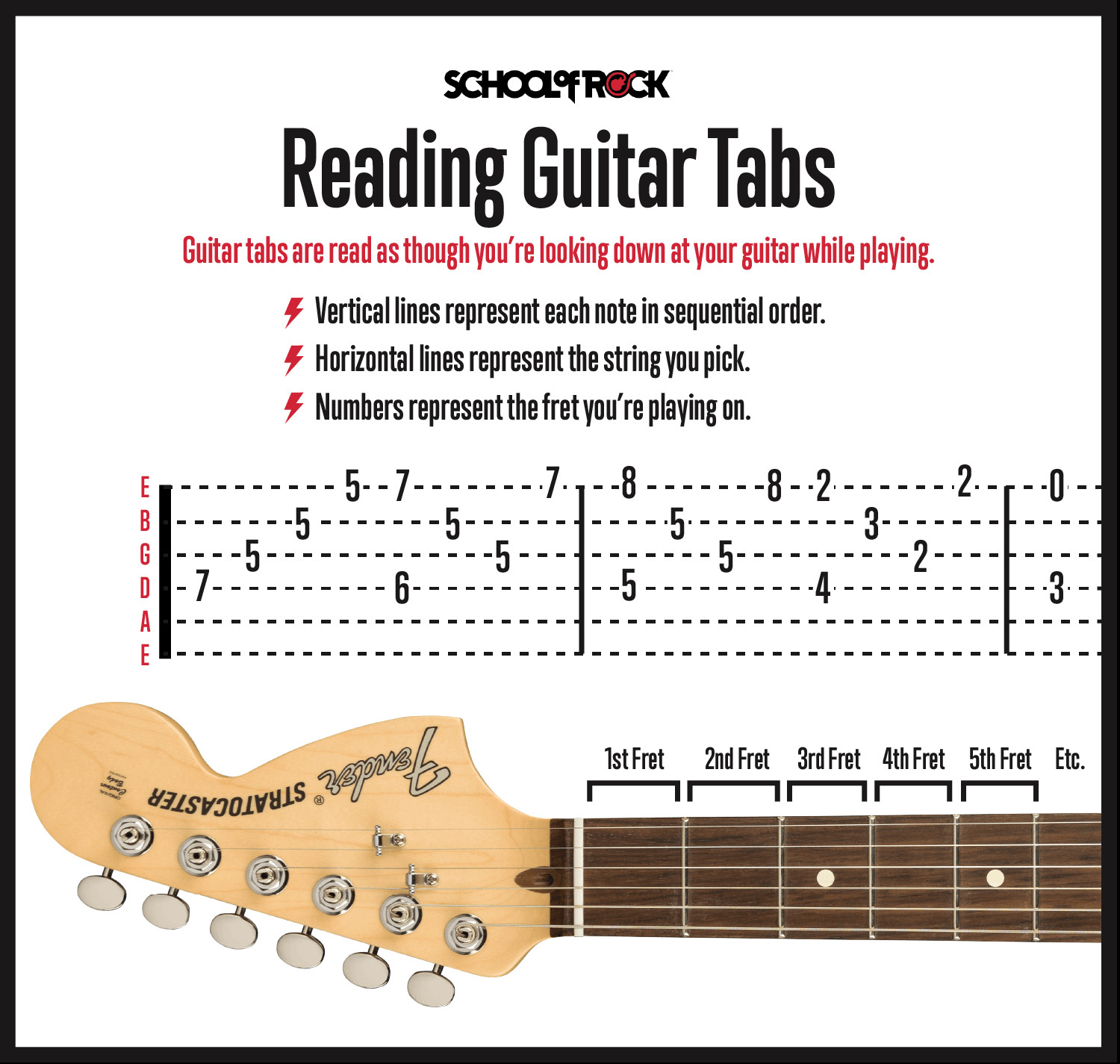 Reading Guitar Tabs Easily
Reading Guitar Tabs Easily
Numbers overlaid on these lines are the key to playing. These numbers indicate the fret you should press down on. Frets are the metal strips along your guitar’s neck, numbered 0-24, starting from the nut (closest to the headstock) and extending down the neck.
A ‘0’ on a string means you play that string ‘open,’ without pressing down any frets with your fretting hand. A ‘1’ indicates pressing down at the first fret, ‘2’ at the second fret, and so on. Mastering how to read guitar tabs starts with understanding this simple number-fret correspondence.
 Visual Explanation of Guitar Tablature
Visual Explanation of Guitar Tablature
Reading Guitar Tabs: A Step-by-Step Guide
Guitar tabs are read linearly, from left to right, mirroring the progression of music through time. Notes presented are in chronological order. When numbers align vertically across multiple lines, it signifies a chord. Chords are played by strumming all the indicated strings simultaneously. Guitar tab notation simplifies learning chords for beginners compared to standard notation by directly showing the fret positions for each note within the chord.
Essential Knowledge for Reading Guitar Tabs
To successfully learn how to read guitar tabs, beginners should become comfortable with the names and order of the 6 guitar strings and the location of the frets. This familiarity is crucial for quickly translating the tab notation into finger positions on the guitar and playing the correct notes.
Understanding the Tab Staff
The guitar tab staff visually resembles the staff used in standard music notation, but with a crucial difference. In tabs, the lines represent the 6 guitar strings themselves, not musical pitches as in standard notation.
The topmost line is the high E string, and the bottommost line is the low E string. This direct string representation is what makes learning how to read guitar tabs so intuitive for beginners. The staff is also typically labeled “TAB” to avoid any confusion with standard notation.
Navigating Guitar Frets
Guitar frets are the metal strips running perpendicular to the strings along the fretboard.
Most guitars feature between 19 and 24 frets. Each fret represents a semitone or half step in musical pitch. There are 12 semitones in an octave. Most guitars include fret markers, often dots or inlays, at the 3rd, 5th, 7th, 9th, and 12th frets. These markers serve as visual guides to quickly locate fret positions while playing.
Remember, numbers on the tab staff represent fretted notes, while ‘0’ denotes an open string. An open string is played by picking or plucking the string without pressing down on any fret, allowing it to vibrate freely.
Interpreting Guitar Tab Chords
Guitar chords in tablature don’t have unique symbols but are easily recognized by their vertical alignment. When multiple numbers are stacked vertically on the tab staff, they are played together as a chord. If a chord is arpeggiated, meaning the notes of the chord are played individually rather than strummed together, they will appear as single notes in sequence, even though the underlying chord shape is implied.
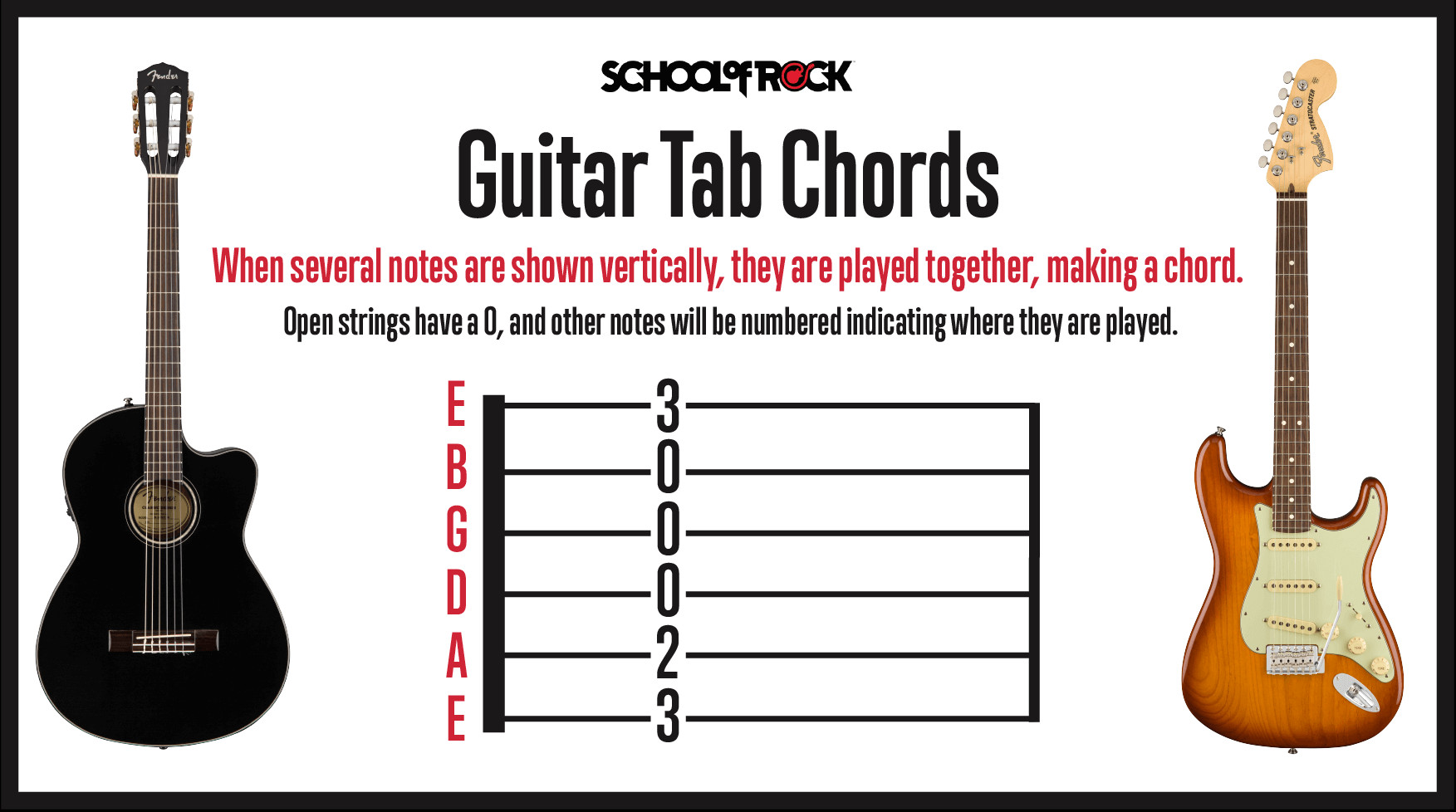 Reading Guitar Tab Chords Explained
Reading Guitar Tab Chords Explained
Recognizing Guitar Tab Riffs
Many rock and popular songs are built around ‘riffs’. Riffs are short, repeated musical phrases, often combining single notes and partial chords, like power chords. In guitar tabs, the same principle applies to riffs: vertically aligned notes are played simultaneously. This consistency makes learning how to read guitar tablature for riffs straightforward and efficient.
Guitar Tabs vs. Chord Charts: Key Differences
Guitar tabs and chord charts serve different but complementary purposes. A chord chart is a visual diagram showing you where to place your fingers on the fretboard to form a specific chord. It might also suggest which fingers to use. Chord charts are often placed above song lyrics to indicate chord changes.
Chord charts typically only display the root chord and the essential 3 or 4 notes that define it. However, a full guitar arrangement may include single notes, passing notes, or arpeggios that are not directly represented in a basic chord chart. For this reason, guitar tabs are often used in conjunction with chord charts to help beginners transition from basic chord strumming to playing more detailed and nuanced song arrangements.
Understanding Finger Numbering in Chord Charts
Chord charts, unlike tabs, sometimes use a numbering system to suggest finger placement. This system refers to the fingers of your fretting hand: 1 for the index finger, 2 for the middle finger, 3 for the ring finger, and 4 for the pinky finger.
Guitar tabs, on the other hand, use numbers to indicate frets, not fingers. Therefore, chord charts can be a helpful addition to guitar tabs, especially for beginners, by providing guidance on hand positioning and fingerings for chords.
Experience the Thrill of Live Guitar Performance
Our guitar programs are led by experienced, practicing musicians dedicated to helping you learn and grow. Develop your skills in a supportive environment suitable for all levels, and take the stage to perform live!
Guitar Tab Symbols: Beyond Numbers
Beyond lines and numbers, guitar tabs use a variety of symbols to indicate specific playing techniques. Learning these symbols is crucial for accurately interpreting tabs and adding authenticity to your playing.
Before you start playing, always double-check your guitar tuning. Correct tuning is essential for your guitar to sound right.
Mastering Muting Techniques
Muting is a fundamental technique in many genres, especially rock music. Styles like heavy metal, punk, and alternative rock heavily rely on muting to achieve their characteristic sounds.
How to Mute Guitar Notes
Muting can be achieved with either your picking hand, your fretting hand, or a combination of both. It adds dynamic variation to your playing and is essential for a polished sound. Many songs use muting in verses and release it in choruses or hooks for contrast.
Experienced guitarists often use muting instinctively to control unwanted noise and feedback, especially at higher volumes.
Guitar Technique: Palm Muting
Palm muting is a widely used technique in rock guitar. It involves resting the edge of your picking hand’s palm lightly on the strings near the bridge while picking. Heavy palm muting creates a tight, percussive sound, while lighter palm muting allows notes to ring out slightly more. Guitar tabs indicate palm muting with “P.M.” above the section where it should be applied.
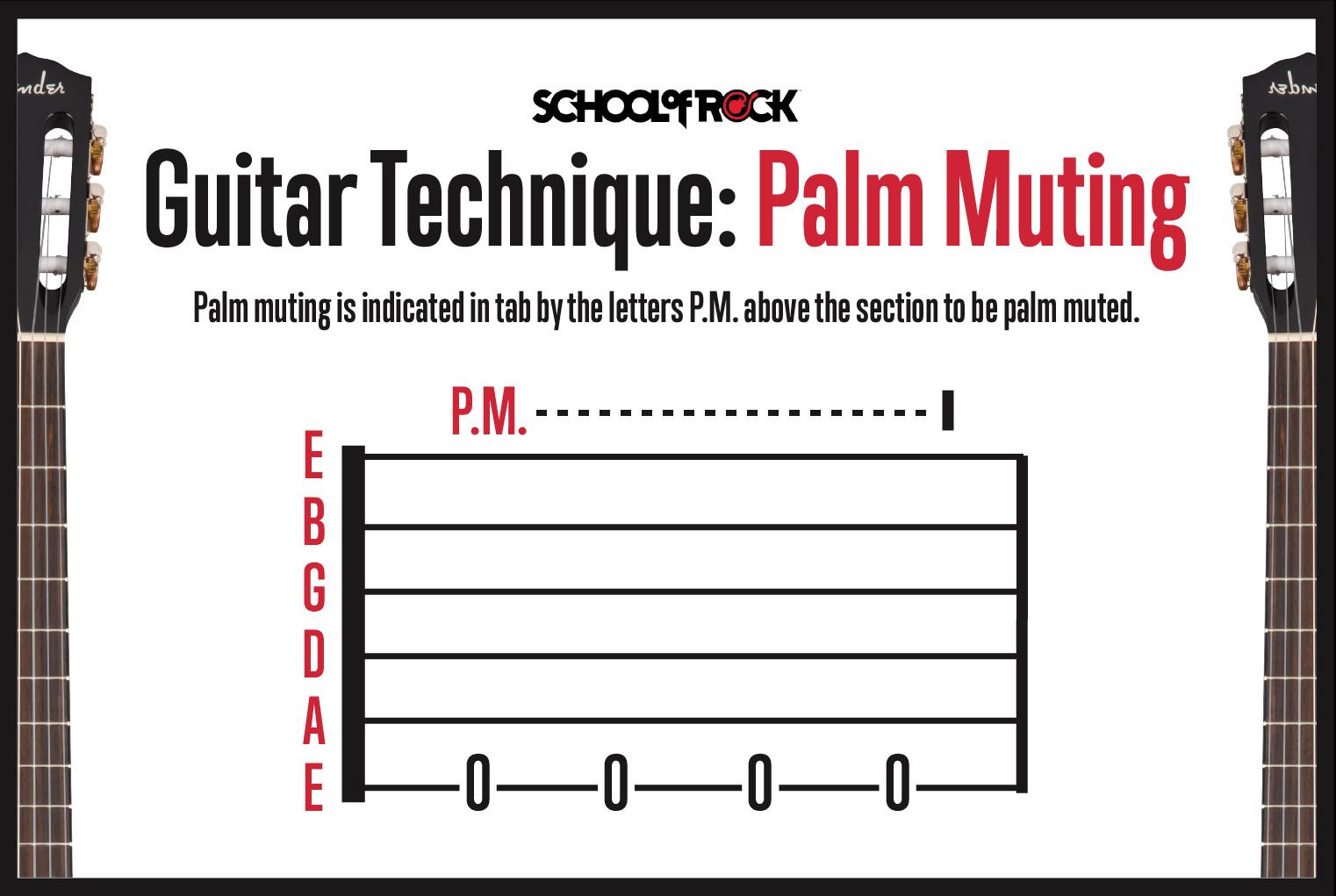 Palm Muting Guitar Technique
Palm Muting Guitar Technique
Guitar Technique: Muted Notes (Fretting Hand Muting)
Muted notes, distinct from palm muting, are achieved using the fretting hand. In this technique, the strings are picked, but the fretting hand lightly touches the strings without fully pressing them down to the fretboard. This creates a percussive, choked sound. Guitar tabs represent muted notes with an “X” in place of a fret number.
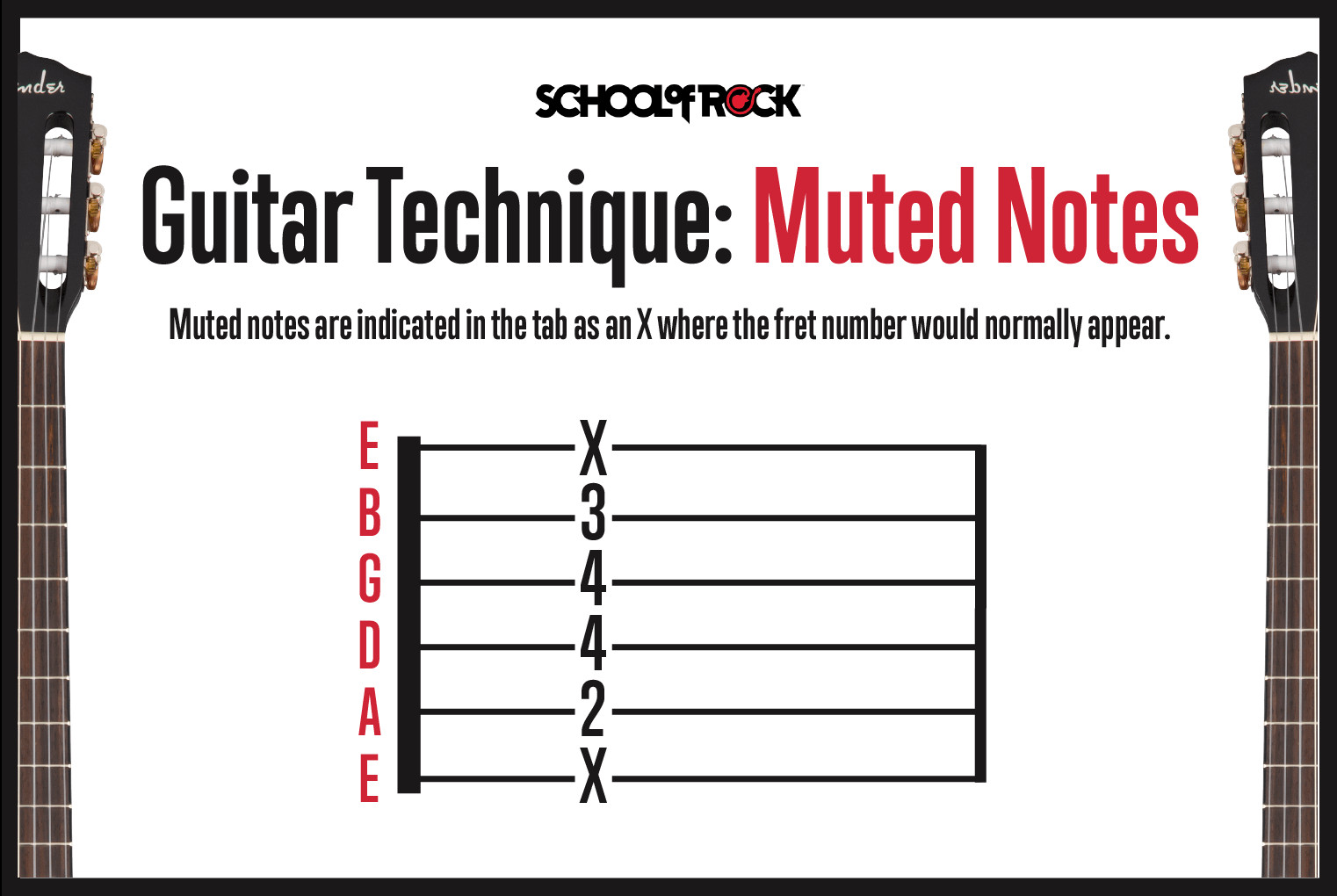 Fretting Hand Muted Notes Technique
Fretting Hand Muted Notes Technique
Bending Guitar Strings for Expression
String bending is a powerful technique for adding expressive, vocal-like qualities to guitar playing. In guitar tabs, bends are indicated by a curved arrow above the note to be bent. The arrow may specify the bend amount, such as “½” for a half step bend (one fret) or “full” for a full step bend (two frets). These target pitches are often referred to as “target notes.”
How to Bend Guitar Strings
Bending involves pushing or pulling the string sideways across the fretboard, rather than just pressing down. For most strings (except the low E), you typically push upwards towards the ceiling. The low E string is usually bent downwards towards the floor. The key is to apply smooth, consistent pressure throughout the bend.
Guitar Technique: String Bending Technique
Most string bends are executed using 2 or 3 fingers for added strength and control. The primary fretting finger (often the ring finger) is supported by the middle and index fingers. This technique ensures smoother bends and better pitch accuracy.
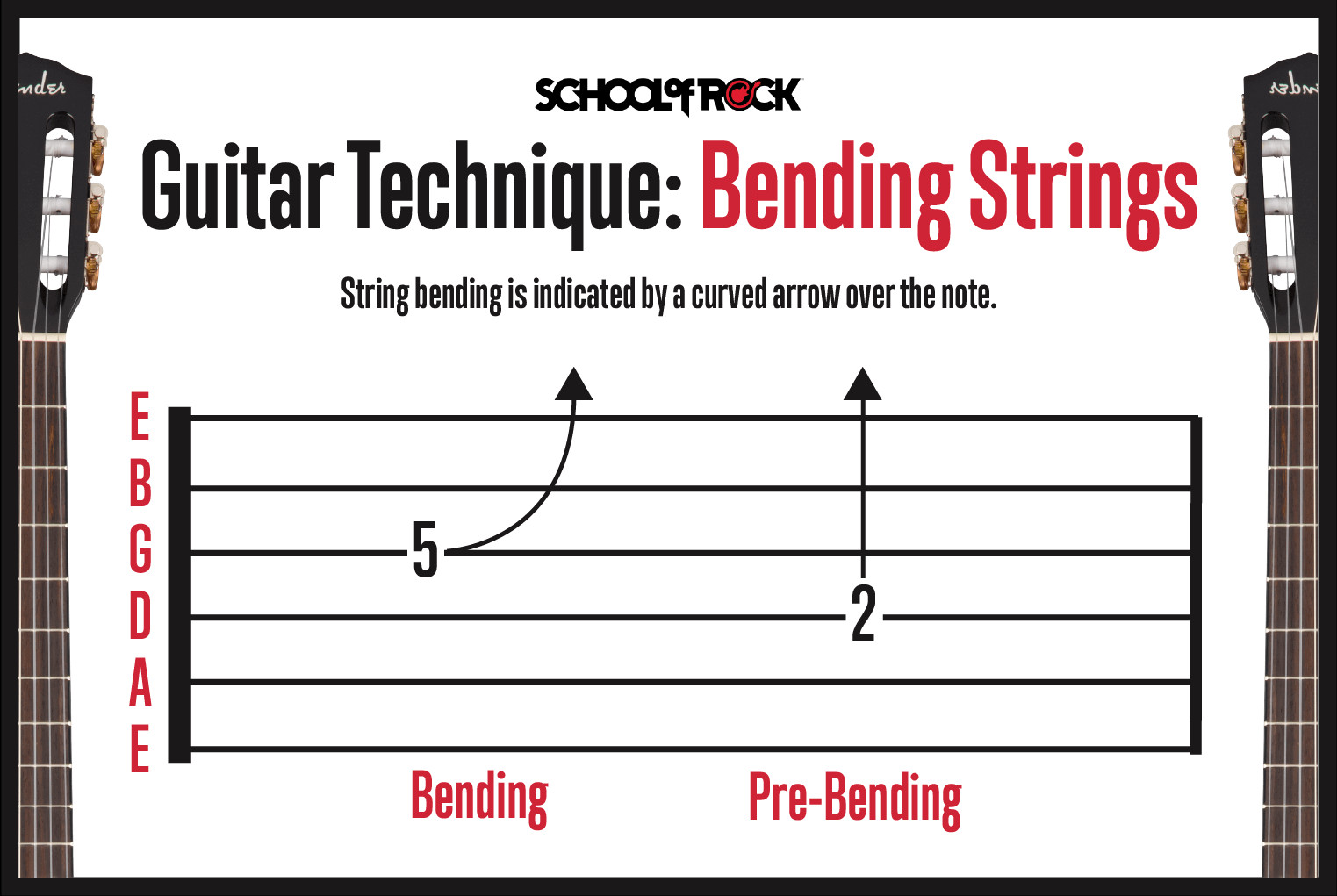 String Bending Guitar Technique
String Bending Guitar Technique
Guitar Technique: Pre-Bending Guitar Strings
Beginners learning guitar tabs may also encounter “pre-bends.” A pre-bend involves bending the string to the target pitch before picking the note. The tab shows this with an upward arrow indicating the bend amount (full, ½, etc.), followed by a downward curved arrow indicating the release of the bend back to the original pitch after picking. Pre-bends can resolve back to the original note or bend further to another target pitch.
Sliding Guitar Notes Smoothly
Sliding is another essential guitar technique that creates a smooth transition between notes. You can slide upwards to a higher note or downwards to a lower note. Sliding differs from bending as it involves moving your fretting finger along the fretboard to the target fret, maintaining contact with the string.
Guitar Technique: Slide Up
An upward slide in guitar tabs is represented by a line connecting the starting note to the higher destination note. The line often slants slightly upwards to visually indicate the upward direction of the slide.
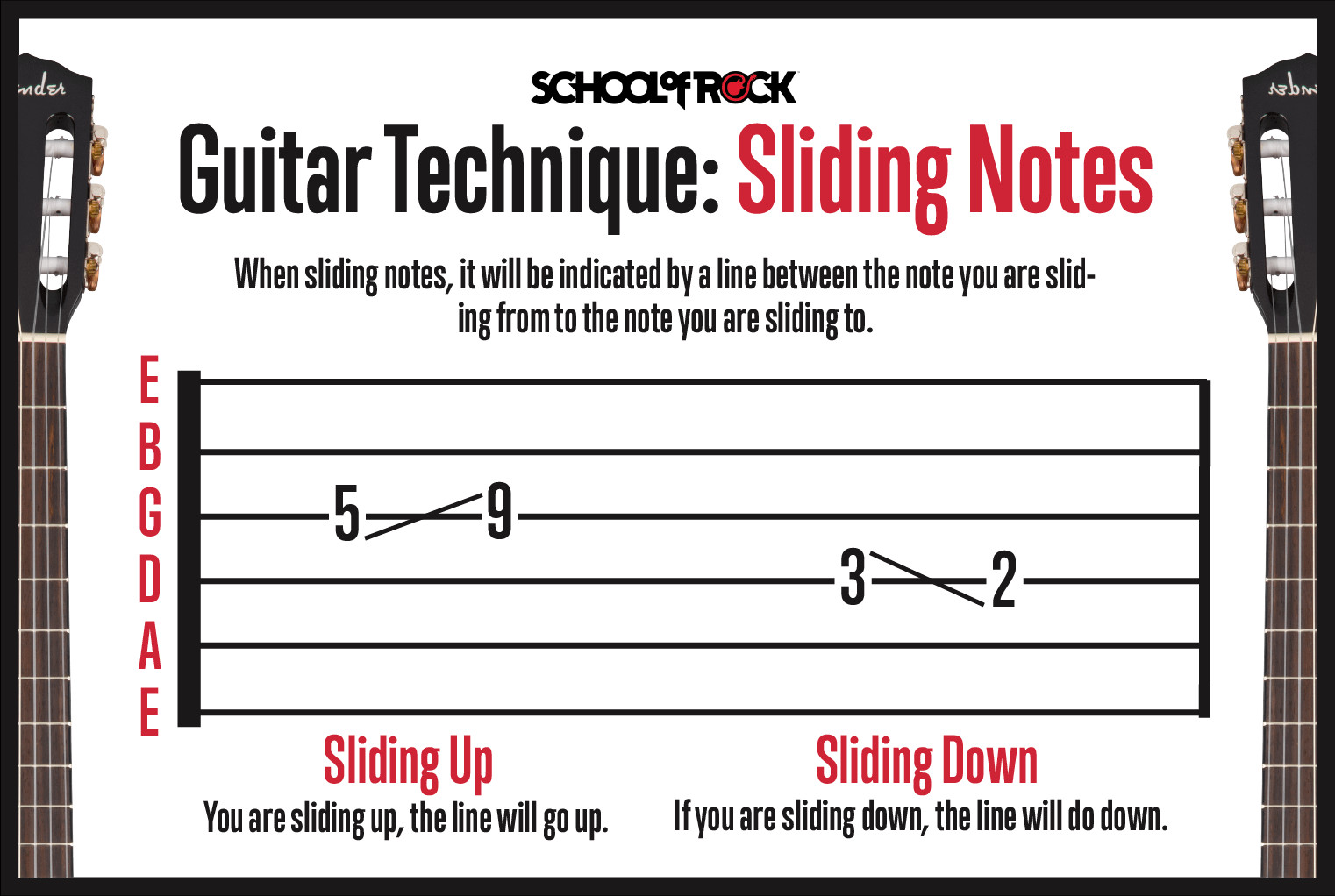 Slide Up Guitar Technique
Slide Up Guitar Technique
Guitar Technique: Slide Down
Conversely, a downward slide is shown by a line connecting the starting note to the lower destination note. This line may slant slightly downwards to indicate the downward direction.
Hammer-Ons: Creating Notes with Fret Hand
The hammer-on is a technique where you produce a note by sharply ‘hammering’ down onto a fret with your fretting finger, without picking the string again. You can hammer-on from an open string or a previously fretted note, always resulting in a higher pitched note. Hammer-ons are indicated in guitar tabs with the letter “H” and an arc connecting the initial note to the hammered-on note.
How to Play Hammer-Ons on Guitar
To execute a hammer-on, strike the string with your fretting finger with enough force to make the note sound clearly. This requires practice to achieve a strong, clean tone. It’s often easier to perform on electric guitars, especially at higher volumes. Start by trying a hammer-on from an open low E string to the third fret, allowing the note to ring. Practice this on different strings and frets.
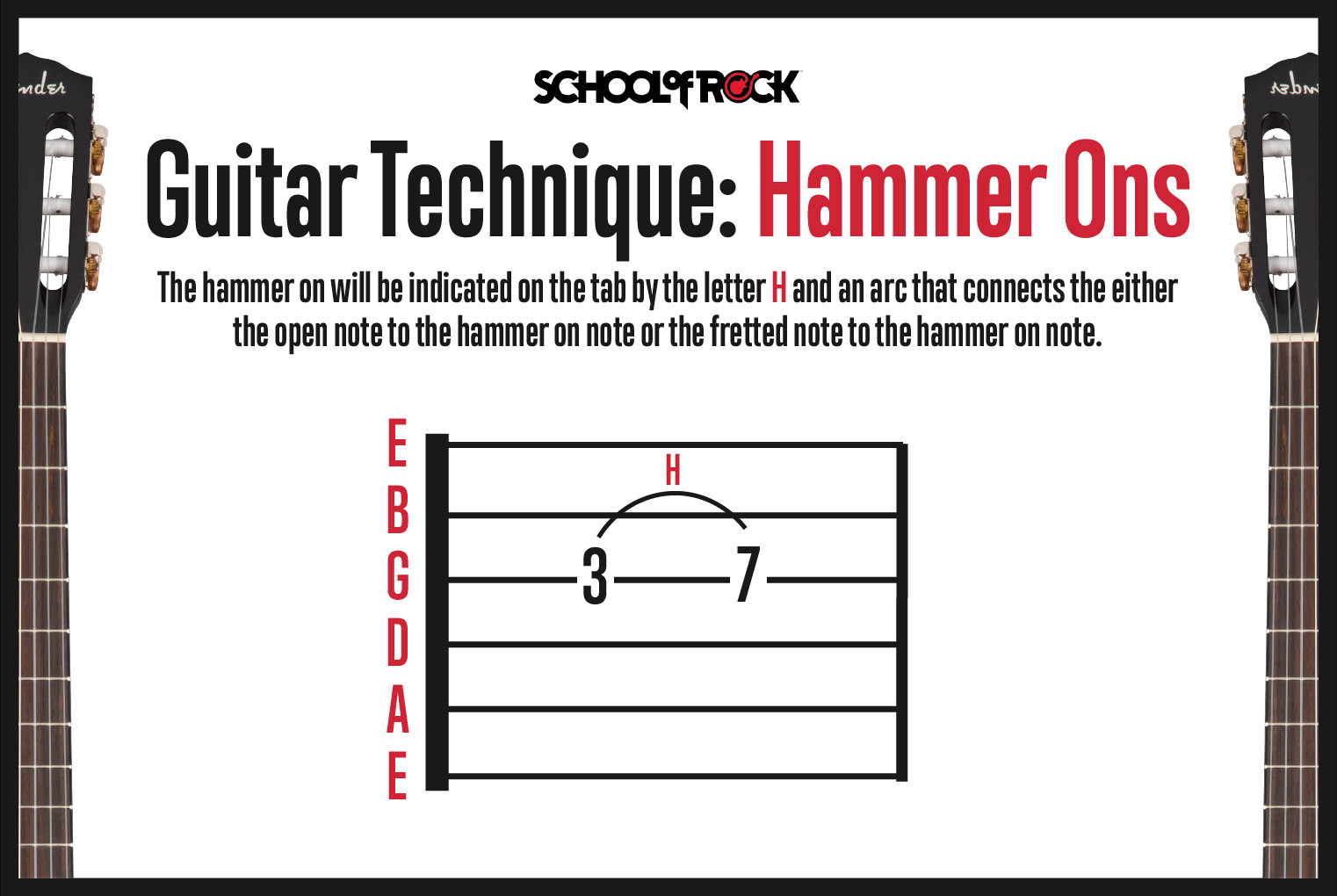 Hammer-On Guitar Technique
Hammer-On Guitar Technique
Pull-Offs: Releasing Notes with Fret Hand
Pull-offs are the opposite of hammer-ons. Instead of hammering on, you ‘pull off’ a fretted finger to sound either an open string or a lower fretted note. Pull-offs are represented in guitar tabs with the letter “P” and an arc connecting the pulled-off note to the resulting lower note.
How to Play Pull-Offs on Guitar
To perform a pull-off, fret a note and then pull your finger off the string in a sideways or downward motion, effectively plucking the string as you release pressure. This action causes the string to vibrate and sound a note, either open or fretted by another finger. When practicing pull-offs, focus on ‘grabbing’ enough of the string with your fingertip to produce a clear tone.
Hammer-ons and pull-offs can be combined in alternating sequences, creating a fluid and fast technique sometimes called a ‘trill.’
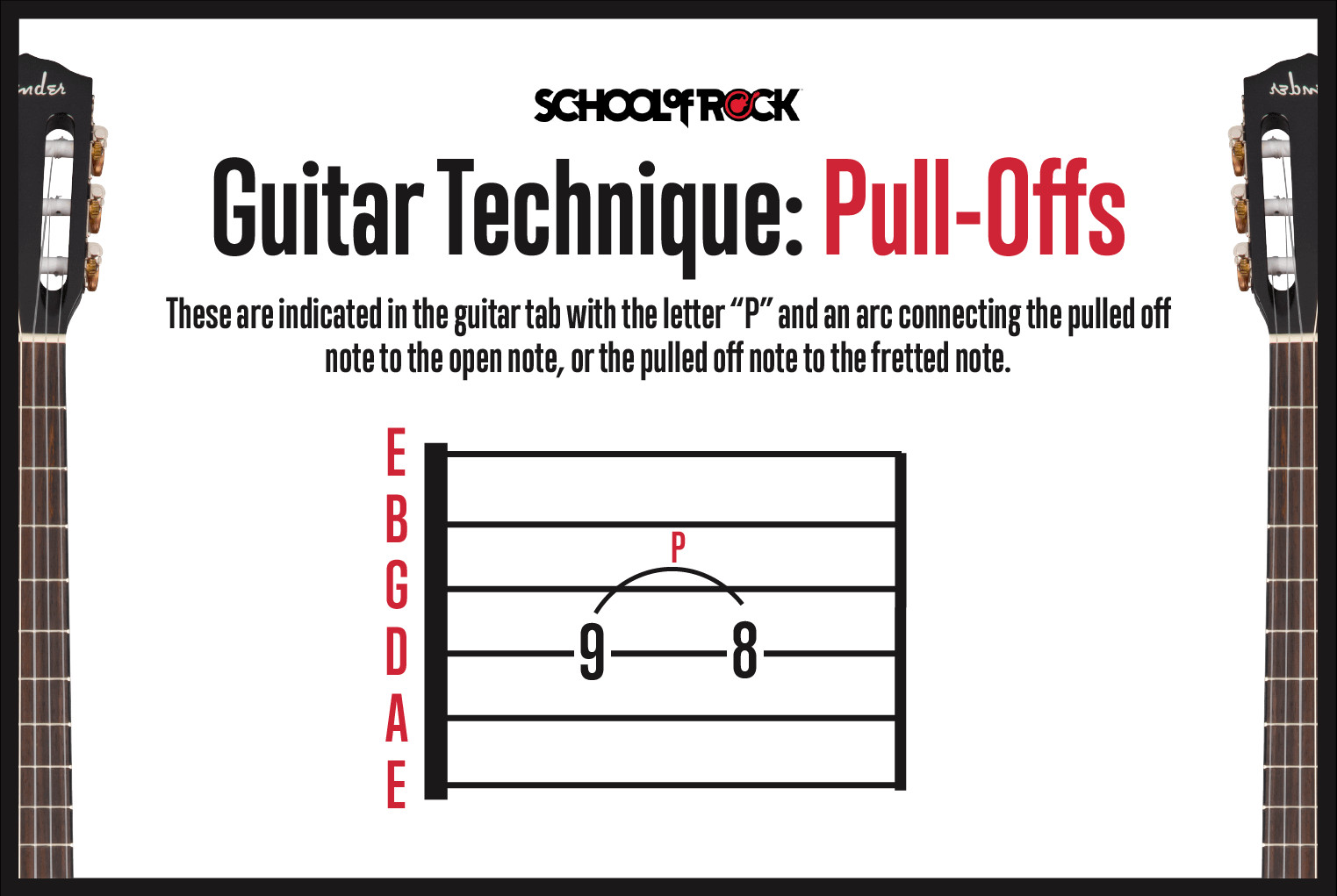 Pull-Off Guitar Technique
Pull-Off Guitar Technique
Vibrato: Adding Expression and Warmth
Vibrato is a technique that adds warmth and expressiveness to notes. It involves subtly and repeatedly bending and releasing a note without fully releasing pressure from the string. This creates a wavering or pulsating effect in the note’s pitch. Vibrato is shown in guitar tabs as a zig-zag line above the staff. The length of the zig-zag line often indicates the duration of the vibrato effect.
How to Play Vibrato on Guitar
Vibrato is similar to bending but with a smaller pitch variation. You can apply vibrato using a single finger or by supporting your main fretting finger with others. Start practicing with a slow, smooth vibrato and gradually experiment with different speeds to achieve various expressive effects. Like bending, vibrato is a highly personal technique; every guitarist develops their unique vibrato style.
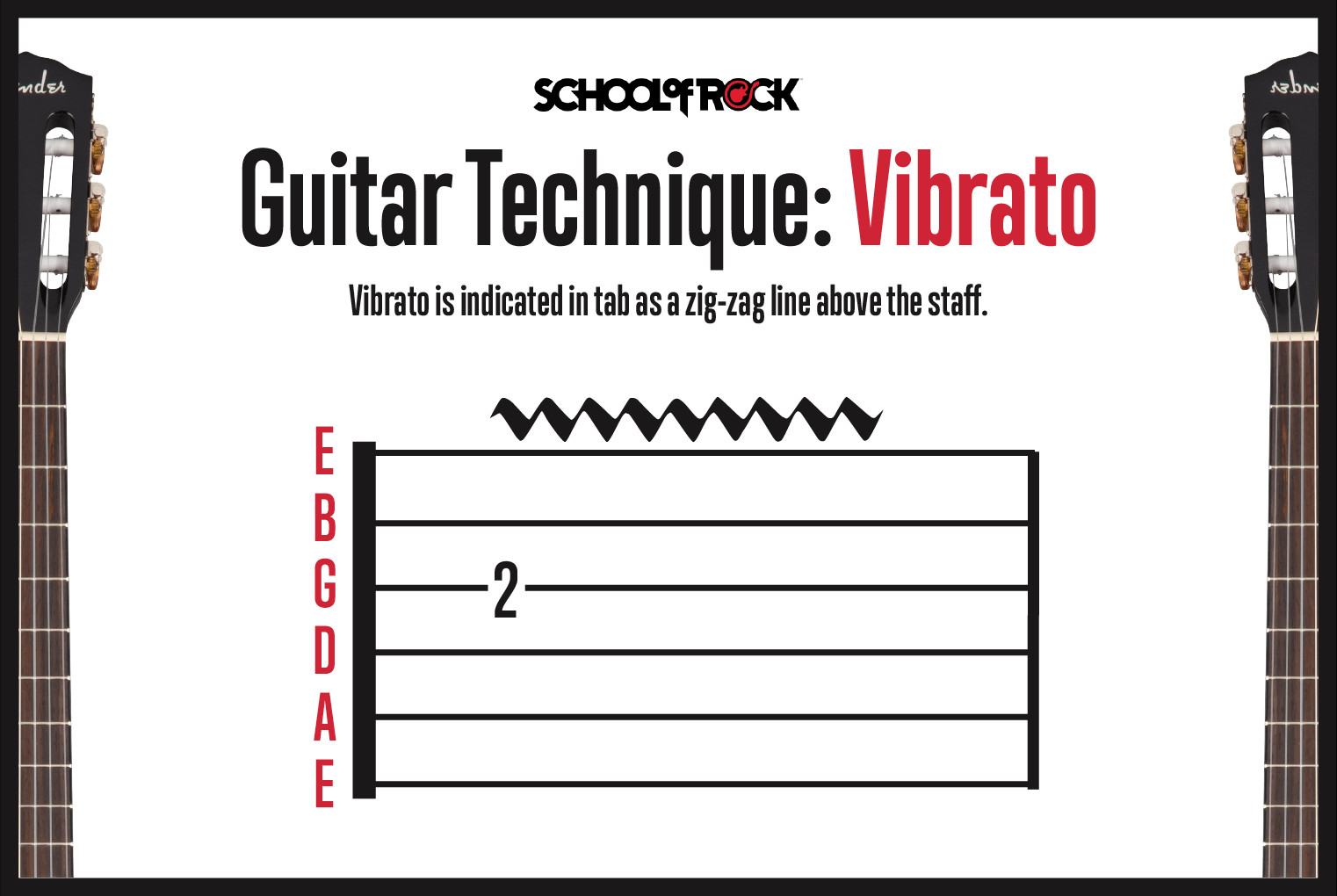 Vibrato Guitar Technique
Vibrato Guitar Technique
Tapping: Expanding Your Guitar’s Range
Tapping is an advanced technique that expands the guitar’s sonic possibilities. It involves using the index finger of your picking hand to ‘tap’ or fret notes on the fretboard, in addition to using your regular fretting hand. Picking-hand tapping is essentially a variation of a hammer-on. Tapping is notated in guitar tabs with the letter “T” above the tapped note.
How to Finger Tap on Guitar
Tapping was popularized by Eddie Van Halen, but the technique has roots in classical guitar. To finger tap, fret a note with your fretting hand and then ‘tap’ a higher note on the same string with your picking hand’s index finger.
Tapping allows you to play notes with intervals that are too wide to reach with just your fretting hand. Playing with overdrive or distortion enhances the clarity and sustain of tapped notes. Tapping also allows for very rapid playing due to utilizing both hands on the fretboard.
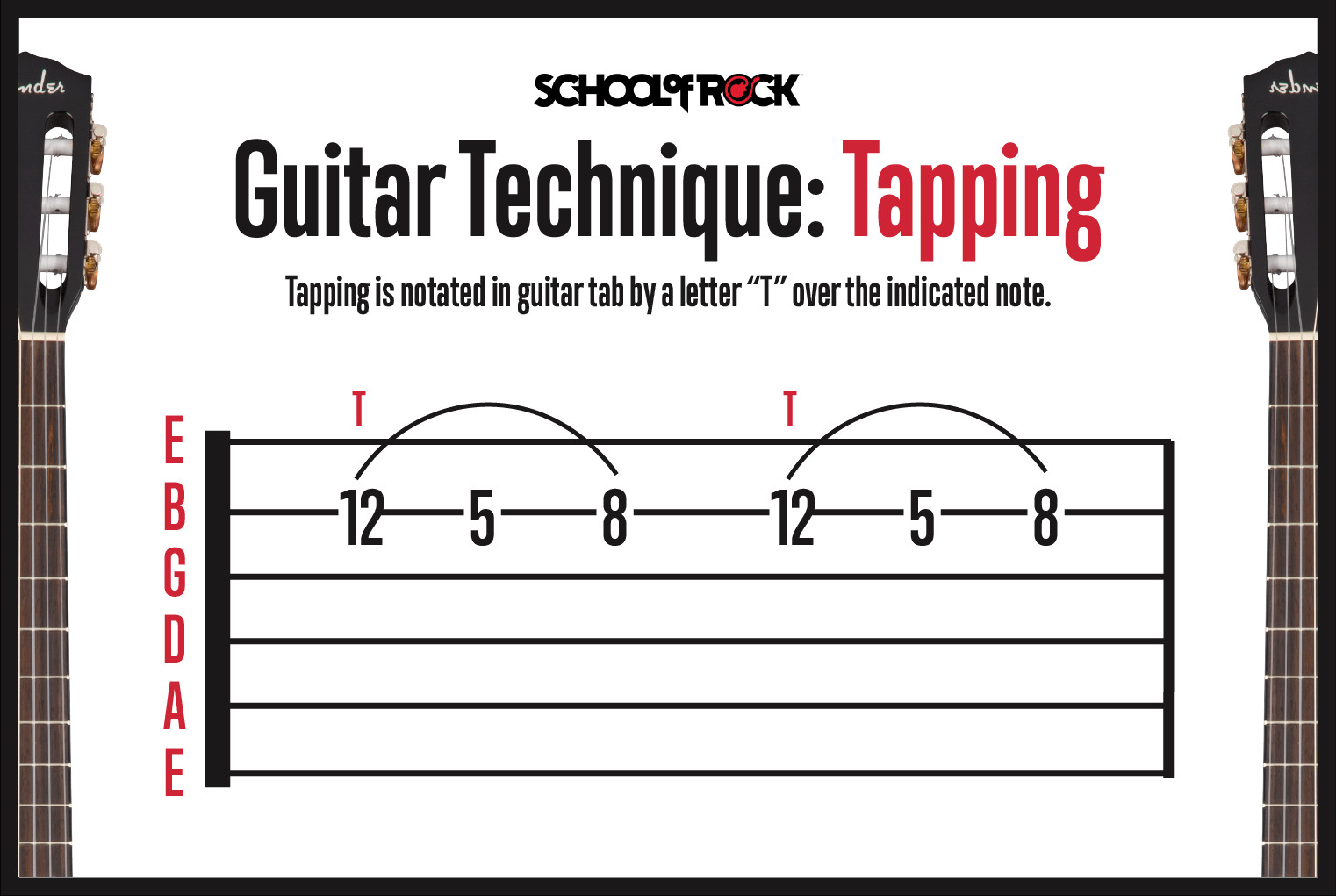 Tapping Guitar Technique
Tapping Guitar Technique
Guitar Technique: Two-Handed Tapping
Two-handed tapping takes the technique further, enabling both hands to independently fret notes without traditional picking. Both the fretting and picking hands perform hammer-ons, often with the fretting hand handling bass notes and the picking hand playing melody or solo lines.
Strumming Guitar Chords Rhythmically
When strumming chords, there are two fundamental strumming directions: downstrokes and upstrokes.
Downstrokes are played from the lower strings to the higher strings using a downward motion of the pick or strumming hand. In guitar tabs, downstrokes are represented by a symbol resembling a thick horizontal line with two short vertical ‘legs’ pointing downwards on either side.
Upstrokes are the opposite, played from the higher strings to the lower strings with an upward motion. Upstrokes in guitar tabs are notated with a “V” shaped symbol.
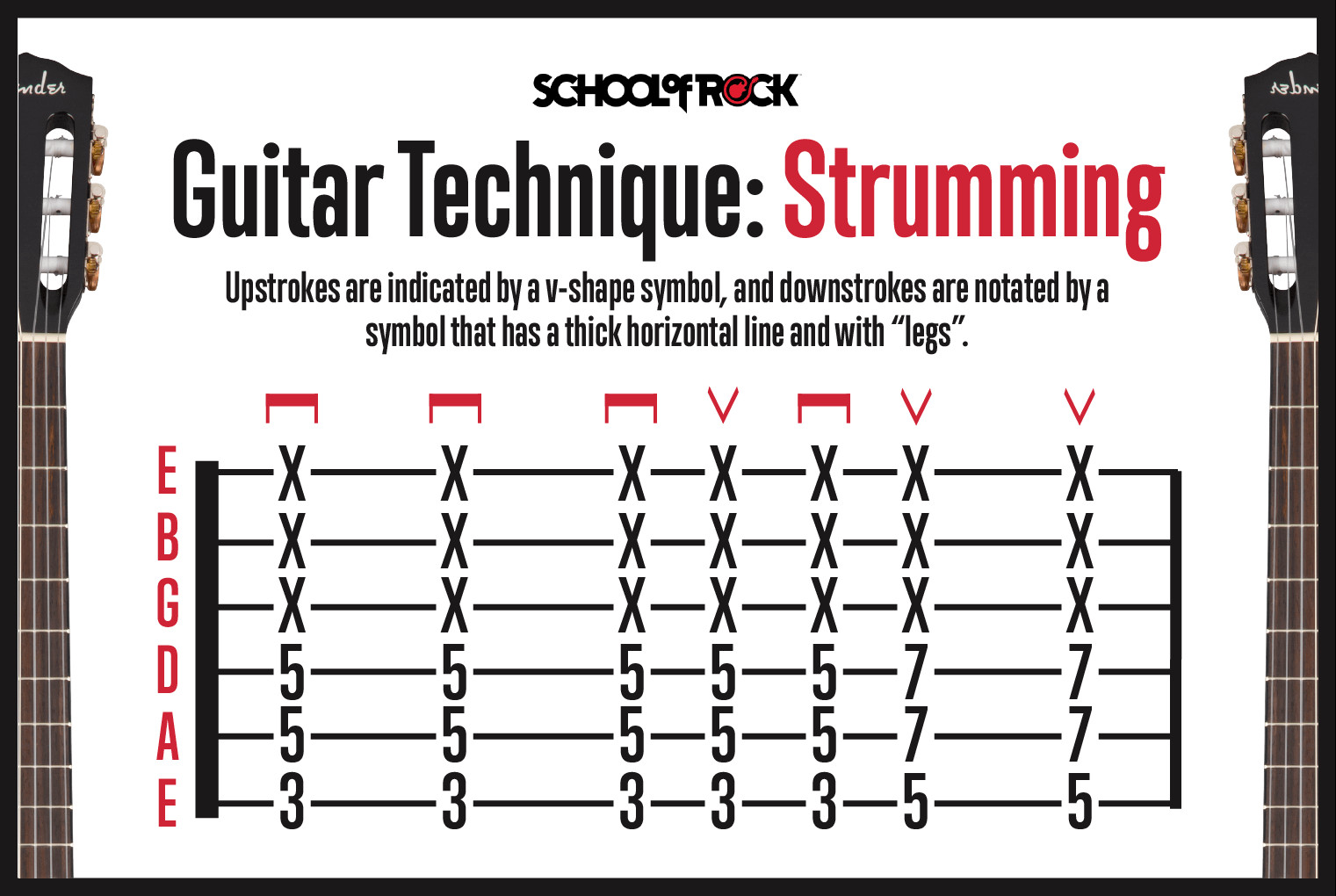 Strumming Guitar Technique
Strumming Guitar Technique
How to Strum Guitar Chords Effectively
Various strumming patterns are used in guitar playing, depending on the song’s rhythm. You can use a consistent down-up strumming pattern or combine downstrokes and upstrokes in countless rhythmic variations. Songs in ⅛ note rhythm are often counted as “1 and 2 and 3 and 4 and…”. Many songs utilize alternating downstrokes and upstrokes in an ⅛ note rhythm, with downstrokes on the numbered beats (1, 2, 3, 4) and upstrokes on the “ands.”
Guitar Technique: Downstrokes and Upstrokes for Single Notes
The same downstroke and upstroke notation applies to single notes in guitar tabs. A downstroke is played with a downward pick motion and is indicated by the horizontal bar symbol. Upstrokes are played with an upward pick motion and are notated with the “V” symbol above the note.
Ready to Explore More Guitar Techniques?
Now that you’ve unlocked the basics of reading guitar tabs and understanding essential guitar techniques, you’re well-equipped to start playing! From beginner strumming to advanced tapping, guitarplayers.net is here to guide you on your musical journey. Our resources and lessons cater to all skill levels, helping you learn to play your favorite songs and reach your full potential.
Eager to find guitar tabs and start playing? From simple beginner songs to complex pieces for advanced players, we’ve got you covered. Explore our curated collection of high-quality guitar tabs and sheet music to find your next song to master.
Thinking about getting a new guitar? Check out our Comprehensive Guitar Buying Guide for expert advice!
